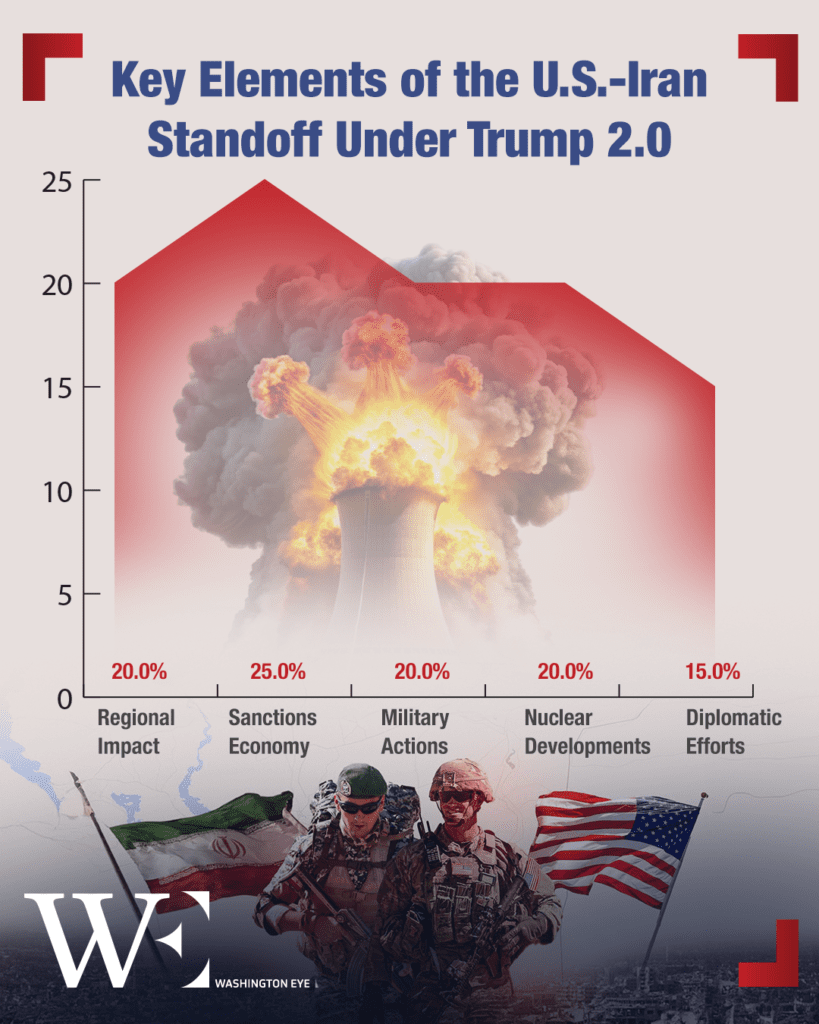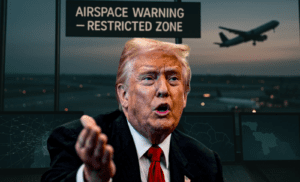As U.S. President Donald Trump makes his mark in White House in his second term, one of the most pressing geopolitical challenges he faces is the ongoing nuclear escalation with Iran. His administration has revived the “maximum pressure” campaign, a hallmark of his previous tenure, aimed at curbing Tehran’s nuclear ambitions and regional influence. This renewed policy involves reinstating stringent economic sanctions, reinforcing military deterrence, and re-engaging in a complex web of diplomatic maneuvers that could either lead to a breakthrough or escalate tensions into a full-fledged crisis.
The Trump administration’s strategy is built upon a foundation of severe economic sanctions, particularly targeting Iran’s vital oil exports. By re-imposing restrictions on Iranian crude, the U.S. aims to reduce Iran’s revenue streams, thereby limiting its ability to finance nuclear development and regional militias. The immediate consequences have been stark: Iran’s economy has been battered by inflation, its currency has depreciated significantly, and foreign investments have dried up. The nation’s economic turmoil has triggered political instability, leading to the resignation of key officials such as Vice President Mohammad Javad Zarif and the impeachment of Economy Minister Abdolnaser Hemmati.
Iran, however, has demonstrated resilience in the face of these economic hardships. Through clandestine oil sales, barter agreements, and enhanced trade partnerships with China and Russia, Tehran has sought to circumvent U.S. sanctions. Reports indicate that Iranian oil exports to China, though reduced, continue through indirect channels, including ship-to-ship transfers and sales labeled under intermediary countries. Russia, a strategic ally, has also played a role in mitigating the impact of these sanctions, with energy cooperation agreements facilitating alternative trade routes.
Parallel to its economic measures, the U.S. has escalated its military presence in the Middle East, responding to Iran’s increasing assertiveness. One of the most significant developments has been large-scale air and naval strikes against the Iran-backed Houthi rebels in Yemen. The Houthis, emboldened by Tehran’s support, have stepped up attacks on Red Sea shipping lanes and Saudi infrastructure, prompting a decisive U.S. response.
Described as the most extensive military operation of Trump’s second term, the recent airstrikes targeted Houthi leadership, missile bases, and drone launch sites. Washington framed the strikes as necessary for restoring stability in the Red Sea, a key global trade route, while simultaneously sending a warning to Iran regarding its involvement in proxy warfare. The U.S. Navy has also bolstered its presence in the Arabian Gulf, with additional aircraft carriers and destroyers deployed to deter further Iranian provocations.
Iran has responded with defiance, warning that continued U.S. military action could prompt retaliatory strikes on American assets in the region. Iranian Revolutionary Guard Corps (IRGC) officials have publicly stated that American bases in Iraq and Syria are within range of their ballistic missiles, increasing fears of a broader conflict. In addition, Iran has accelerated its military cooperation with Russia, reportedly receiving advanced drone and missile technology in exchange for supplying Moscow with weaponry for its war in Ukraine.
In an attempt to shift the narrative away from military confrontation, President Trump extended an invitation to Iran’s Supreme Leader, Ayatollah Ali Khamenei, proposing new nuclear talks. However, Tehran swiftly dismissed the offer, labeling it a deceptive maneuver. Iranian officials, citing previous failed negotiations, expressed skepticism about the U.S.’s sincerity, particularly given the simultaneous imposition of new sanctions.
Iran’s position remains clear: it demands the complete removal of sanctions before considering any return to the negotiating table. The Iranian leadership views U.S. diplomatic overtures as insincere, designed merely to exert pressure rather than to reach a meaningful agreement. Meanwhile, European allies, particularly France and Germany, have sought to mediate, urging both parties to engage in dialogue to prevent further escalation.
The crux of the conflict remains Iran’s nuclear ambitions. Despite U.S. sanctions, the International Atomic Energy Agency (IAEA) has reported that Iran has significantly ramped up its uranium enrichment activities. Intelligence sources indicate that Tehran has begun enriching uranium to near weapons-grade levels, sparking concerns that it is on the verge of achieving nuclear breakout capability—the point at which it could rapidly produce a nuclear weapon if it chose to do so.
Israeli officials, long wary of Iran’s nuclear trajectory, have heightened their rhetoric, warning of potential pre-emptive strikes if Tehran crosses the nuclear threshold. Israeli Defense Forces (IDF) have reportedly intensified their planning for a military option, with speculation that a strike could target key Iranian nuclear facilities in Natanz and Fordow. The U.S., while not explicitly endorsing Israeli military action, has reaffirmed its commitment to preventing Iran from acquiring nuclear weapons, further complicating diplomatic efforts.
The escalating tensions between the U.S. and Iran have profound implications for the broader Middle East. The Gulf states, particularly Saudi Arabia and the UAE, find themselves in a precarious position. While they support Washington’s stance on curbing Iranian aggression, they are also wary of being drawn into a direct conflict. Saudi Arabia, in particular, has sought to balance its security concerns with ongoing efforts to de-escalate tensions with Tehran, following last year’s China-brokered rapprochement.
Iraq, caught in the crossfire of U.S.-Iran hostilities, remains a battleground for influence. Iranian-backed militias have stepped up attacks on American bases, while Washington has responded with targeted strikes. The Iraqi government, seeking to maintain stability, has attempted to navigate between these two powers, urging restraint and diplomatic engagement.
Beyond the Middle East, the crisis has economic ramifications. Global oil markets remain volatile, with prices fluctuating based on fears of supply disruptions in the Arabian Gulf. The potential for a broader military conflict raises concerns over energy security, particularly for European and Asian economies that rely heavily on Gulf oil shipments.
As Trump’s second term unfolds, the U.S.-Iran standoff remains a defining challenge. The maximum pressure campaign, while crippling Iran’s economy, has yet to achieve its ultimate objective of compelling Tehran to abandon its nuclear ambitions. Military deterrence, though effective in containing immediate threats, risks escalating into a larger conflict. Diplomatic efforts, for now, remain in limbo, with Iran unwilling to engage on Washington’s terms.
Looking ahead, several scenarios could unfold:
- Continued Status Quo: The U.S. sustains its maximum pressure campaign while Iran incrementally advances its nuclear program, leading to prolonged tensions.
- Diplomatic Breakthrough: A shift in strategy, possibly with European mediation, leads to renewed negotiations, albeit with significant compromises required from both sides.
- Military Confrontation: A miscalculation or provocation leads to direct military engagement, potentially involving Israel and regional actors.
For now, the situation remains volatile, with no clear resolution in sight. What is certain is that the U.S.-Iran nuclear standoff will continue to shape Middle Eastern geopolitics and global security in the years to come.

















